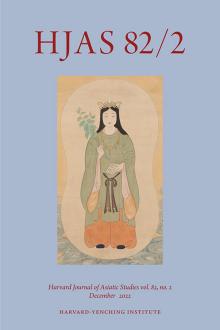December 2022
Fujii Sodō, Yōsan shinzō [nineteenth century], hanging scroll, color drawing on silk, 102.6 × 35.6 cm; No. 013000789, Box 56, Bruno Petzold Collection, Harvard-Yenching Library, Harvard University, Cambridge, MA, https://iiif.lib.harvard.edu/manifests/view/ids:43028297. Image courtesy of Harvard-Yenching Library.
Editorial Preface
Articles
The Rise of Tiba 題跋 as a Literary Genre in Song China
Why did tiba colophons, whose raison d’être depended on being attached to target subjects as addenda, effectively survive as independent texts compiled in literary collections? By tracing the rise of the tiba genre from the mid-eleventh century, I delineate how Northern Song literati explored tiba as a new discursive space to critically engage with material objects, capture group dynamics among connoisseurs, and offer evaluative assessments on the various topics of tiba. The stature of tiba transformed through the twelfth century, when they were compiled into literary collections as stand-alone texts, gradually acquiring sociocultural connotations and status comparable to those of established formal genres. I argue that this process of decontextualizing and recontextualizing proved essential to the rise of tiba during the Song and their popularity during the following centuries.
題跋書寫原是高度依存於所跋對象的,那為何傳世題跋多以文集中所收獨立文本的形式流傳?本文通過追溯題跋這一文本空間從十一世紀中期到十二世紀末的演變,重構題跋在北宋流行的語境,並勾勒其文體生成的關鍵過程⸺題跋脫離所跋對象、與其他題跋共同入集。
Riding Modern Waves
Sea Bathing for Health in Meiji Japan
During the late nineteenth century, leading Japanese doctors promoted therapeutic sea bathing as a means of achieving good health and bodily strength. Influenced by European medical discourses, they advocated the practice as creating the conditions of “hygienic modernity” and the healthy, modern bodies that Japan needed. Ordinary people also embraced sea bathing in ways that drew on their experiences of traditional hot-springs resorts as well as fulfilling newer, modern desires to escape the pressures of everyday life. I chart the social history of sea bathing culture in the Meiji period to show how medical discourses of hygienic modernity were disseminated, popularized, and ultimately transformed. This important case study illustrates the interconnections and tensions between the state-sponsored application of hygienic modernity and popular ideas about preventative medicine, leisure, and pleasure in nineteenth-century East Asia.
明治期、日本の医学者が熱心に海水浴を健康法として勧めた。ヨーロッパの 思想を受けて国民の体力を向上させる目的であった。その結果、海水浴が広まった が、健康よりレジャーと娯楽に変化していった。本研究は海水浴を例として養生と衛 生の関係を考察する。
Unearthing Practice
Networked Authenticity and Sutra Interment
In this article, I conduct a case study of sutra-interment rituals conducted at Buzōji in northwestern Kyushu. Placing twelfth-century practices of sutra burial into creative dialogue with twentieth-century practices of sutra excavation, I propose a model of “networked authenticity.” Thinking about authenticity as networked—distributed across several interconnected nodes—rather than as generated from any single point provides a way of valuing devotional attention as sincere and meaningful, even when aspects of specific instances of devotion may be imperfect. This model opens a way to evaluate the efficacy of imagined traditions, rotted manuscripts, looted sites, and apocryphal texts by recognizing them as part of a larger, interconnected web whose strands may span centuries. I show that sacred texts are products of social negotiation around meaning and authenticity, not the sources of it.
本稿では 12 世紀と 20 ・ 21 世紀武蔵寺経塚と写経埋納法会をケーススタディとして、信仰的な「信憑性」の構造を考察する。結論としては、信憑性の源流は一つ (例えば経典) ではなくて、却っていくらの要素、つまりネットワークで組み立てされる。
